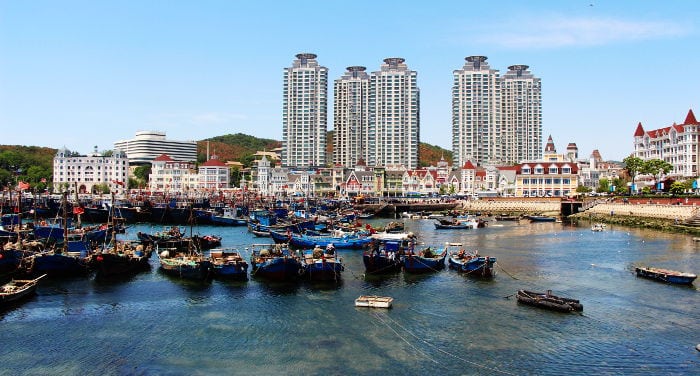
Dalian is the second-largest city in the Liaoning province, and along with Qingdao, is one of the main coastal cities in northern China. It is located on the far south of the Liaodong Peninsula, and is surrounded by the Bohai Sea, on the other side of which is North Korea to the east and the Shandong province to the south.
The city has several hills and a large portion of its coast is made up of cliffs and rocky areas, although as we will see below, it also has nice beaches where you can relax. Moving away from the coast, the city center is much less flat than the majority of large Chinese cities.
This excellent geographic location, which allows to control the maritime traffic that crosses the Bohai Strait, along with the abruptness of the coast, helped to turn this young city with barely 100 years of history into a strategic enclave that both the Russians and Japanese fought for during the first half of the 20th century. Today it is still possible to find small military outposts and anti-aircraft artillery in the coastal areas.
When to go
The best time to visit Dalian to get the most out of the city as well as coastal areas is between the months of May and October, when temperatures are more pleasant. In summer, temperatures are cooler than in the interior, which makes Dalian a good option to escape from the sweltering summer in the central area of the country.
On the other hand, July, August and to a lesser extent, June are the months with the most rain, although the number of days that the sun shines is quite high, even during those months.
In winter, although it’s less rainy, it’s relatively humid and temperatures tend to drop to 0° between December and the end of February. Because of this, those months are the least suitable for enjoying everything that Dalian has to offer.
How to get there and get around the city
Dalian is very well-connected by land, sea and the air, and is turning into an important international transportation hub.
Plane
Zhoushuizi Airport (大连国际机场) is located only 10 km from the city and connects it with the main cities in the country. It’s the largest airport in the country’s northeast and one of the best connected internationally, with flights to Russia, Japan, South Korea, Thailand, Vietnam and Singapore.
The airport is well-connected with the city via line 2 of the subway, with a shuttle bus service and via municipal bus lines 541, 701 and 710. An airport taxi costs between 30 and 40 CNY to downtown.
At the time of writing this guide, the new Jinzhouwan Airport is still under construction, although it is expected to start operations during 2018. It will be larger than Zhoushuizi Airport, which it will replace once it starts to operate. It’s farther away, but it is also planned to be well-connected with the city center.
Click here to learn more about traveling by plane in China
Train
Dalian has two train stations that can connect you with the entirety of the country’s north and northeast:
Dalian Railway Station (大连站), located downtown. It was the first train station that was built and is found in the city’s Russian district. This station is where you can take G-type bullet trains as well as older type K and Z trains headed to Beijing, Harbin, Shenyang and Jilin.
Many bus lines stop in front of the station, along with subway line 3.
Dalian North Station (大连北站) is the newest and was built to accommodate new high-speed lines. It is also connected with the remainder of the city via subway line 3.
Click here to learn more about traveling by train in China
Ferry
Given its strategic location, Dalian has an international passenger port that connects China with the Korean city of Incheon. Other cities that are connected with Dalian via the sea are Tianjin, Yantai and Weihai.
Bus
Dalian is connected to other cities in the Liaoning province and the remainder of northern China by bus through Jianshejie and Guangwaqiao stations, both of which are close to the train station in the city center.
Click here to learn more about traveling by bus in China
Subway
The city’s subway system is very modern and has four lines which let you travel between the main spots in the city, although some coastal areas, which are more mountainous and less populated, don’t yet have this service.
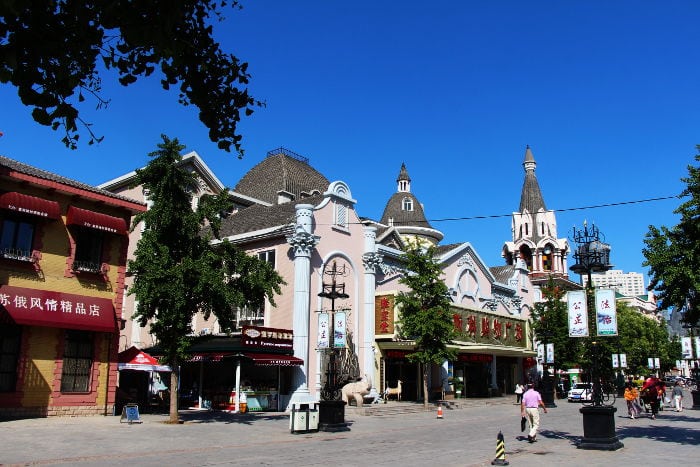 Street with Russian architecture in Dalian
Street with Russian architecture in Dalian
Where to stay
Although Dalian isn’t a main destination for international tourism, its economic development and the presence of foreign companies has encouraged the development of good hotels in the city.
To get the most out of the city, the area around the train station, which is also the city’s financial district, is one of the most recommendable places to stay, as it has a higher density of restaurants and services in addition to being very well-connected.
If you prefer to stay closer to the coast, the Laohutan neighborhood would be a good option. In addition, if you’re looking to stay in a hotel with history, it’s worth mentioning Hotel Bangchui Island, located opposite the island of the same name which is a must-see for local tourists due to its political importance in the country’s recent history. The resort has private beaches, several buildings with a water view and a golf course. It has accommodated some of the most prominent national and international political leaders during their visits to the city.
Click here to view the hotels available in Dalian
What to do in Dalian
Dalian is a city with a relatively short history, which means that its downtown isn’t filled with historical buildings, although there still remain many structures from the Russian colonial era. The city is known for its abundance of plazas. Each plaza has a distinct style and some of them are truly worth visiting.
Given that it is a coastal city, many of the city’s attractions are located on the coast, so don’t hesitate to visit it to enjoy the beautiful views of the Bohai Sea and some of its beaches.
Russian district
The historical area of the city is located around the train station, which makes it a good place to start your visit to the city.
The majority of Russian and European-style buildings are located along Eluosi Fengqing Jie Street (俄罗斯风情街), which is the continuation Victory Bridge. There, you will find a couple of churches, some buildings with a Russian or central European look, and above all a large number of souvenir shops which stand out for their Russian matryoshkas, imported food products and some more original pieces.
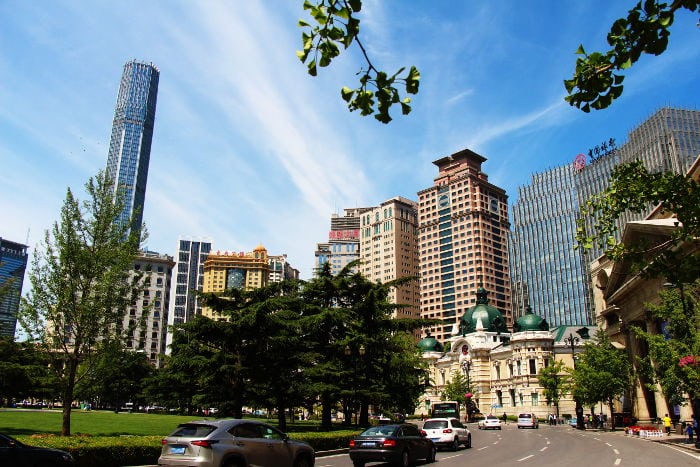 Zhongshan Plaza, where old colonial buildings meet modern towers
Zhongshan Plaza, where old colonial buildings meet modern towers
Plazas
As opposed to many other Chinese cities with a checkerboard design, the majority of the city’s streets don’t follow one direction but rather follow radials that start and finish in some of the city’s many plazas, in their majority circular.
It’s not necessary to visit them all, but it’s worth highlighting Zhongshan, Minzhu and Youhao plazas in downtown and Aolinpike and Renmin plazas, which are a little further away.
Zhongshan Plaza (中山广场) is the most important plaza in the city. It was built during the Russian and Japanese colonial periods and has European-style buildings that currently fulfill administrative and governmental functions, in addition to being home to various banks. It’s a common place for locals to go for a walk, as the majority of the city’s main streets sprout from it.
A meager 300 meters from Zhongshan is Minzhu Plaza (民主广场), where it is also possible to view various European buildings, and which has the charm of being a stop on Dalian’s tram, which helps to create a colonial era ambience.
Youhao Plaza (友好广场), which is also close to Zhongshan, was built to commemorate the friendship between China and the Soviet Union, and despite being surrounded by mainly modern buildings, it stands out due to an interesting spherical crystal sculpture. This sculpture is particularly interesting at night, when it is lit up in multiple colors.
Renmin and Aolinpike plazas, which are rectangular and much larger than the previous ones, are located just over 3 km to the southeast of downtown Dalian. Renmin (人民广场) is mainly composed of a green space and has a musical fountain that is quite eye-catching. It’s surrounded by several local government buildings. Olympic or Aolinbike Plaza (奥林匹克广场) has several structures to commemorate the Olympic Games, including the Olympic rings.
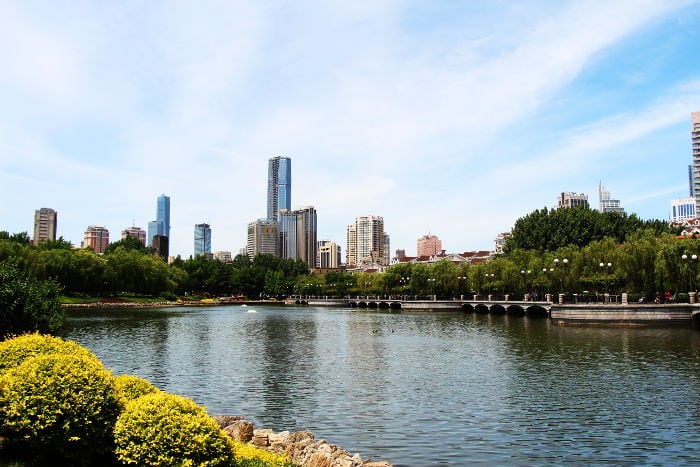 Ertong Park, a favorite place among locals for going for walks
Ertong Park, a favorite place among locals for going for walks
Parks
In addition to its numerous city plazas, Dalian also has many parks, among which is worth highlighting Laodong and Ertong parks. Both of them are found in the area surrounding Zhongshan Plaza.
Laodong Park (劳动公园), the largest in the city center, like many Chinese parks has multiple lakes, recreational areas, food stands and a few fair attractions. Even so, the thing that most attracts the many tourists that visit it are the views from the top of the hill around which this recreational area developed. The view point can be accessed via staircases flanked by the 12 animals of the Chinese zodiac, and once you’ve reached the top it offers a good view of the modern buildings downtown. For those who feel like it, you can go up even farther to the television tower, from which you can see parts of the coast and get a really good idea of the city’s layout.
Ertong Park (儿童公园) or Children’s Park is a lot smaller and is built around an artificial lake. It’s a small place of peace and tranquility in a residential area where you can see many families going for walks.
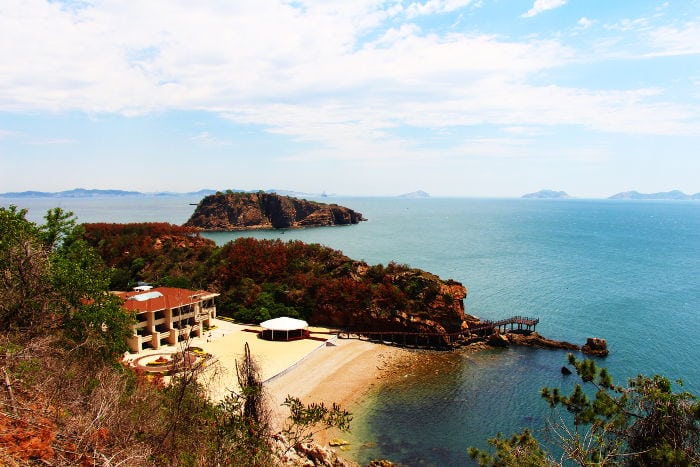 The Dalian coast, with Baochao Island in the background
The Dalian coast, with Baochao Island in the background
The coast
The coast surrounding Dalian’s downtown can be divided into four areas: to the north very close to downtown is the port area; to the northeast is the Bangchui Dao complex, which in addition to the hotel already mentioned offers beaches, cliffs, and vast gardens that combine with the surrounding vegetation; to the east is Laohu tan, a small bay with an ocean park, many green areas and a pleasant seaside boardwalk; to the south is Xinghai Plaza, which according to the locals is the largest plaza in Asia. All of these areas are linked with one another via a beautiful coastal highway that is worth traveling, whether in car, bicycle or on foot.
During my visit, the port area was being renovated and developed, and will soon be converted into an important tourist destination with restaurants and cafés.
The Bangchui Dao Historical Complex (棒槌岛), an area which in the past was a meeting place for important historical leaders and which is the best hotel in the area, is currently a popular destination for weddings and is practically a must-see attraction in the city. You can access the facility through the west gate, which is advisable to reach by taxi, although buses 703 and 712 will also leave you nearby and the trip on foot is worth the effort.
It costs 20 RMB to enter and you will have access to the private beach, the gardens and the different buildings that make up the hotel. My favorite part was the cliffs with views of Bangchuidao Island, after which the hotel is named.
Following Binghai Highway (滨海街) to the south, you will arrive at Laohu Tan Bay (老虎滩). I recommend doing this trip slowly, either on foot or in taxi, to be able to make various essential stops, from which you will enjoy the incredible views of the Bohai Sea and small beaches (a perfect moment to consider that on the other side of the sea and not too far away is North Korea).
The main attraction of Laohu Tan is the ocean park with the same name. It’s the largest enclosure of this type in China and one of the biggest in Asia. It stands out due to its exhibitions of marine animals from the polar regions, coral aquarium and due to the abundance of seabirds. Plus, during the visit, you will be able to enjoy some of the nicest landscapes in the city. The cost of admission is 220 Yuan.
Only 200 meters from the entrance to the ocean park is a small fishing pier that is still active and filled with fishing boats. The pier has been recently restored to hold an open air shopping mall alongside a boardwalk whose buildings are reminiscent of Californian coastal architecture. It’s a perfect place to eat seafood at its pleasant restaurants, which serve a fusion of Chinese and Western food.
Xinghai Plaza (星海广场) is a large oval esplanade almost a kilometer in length surrounded by modern residential buildings to the north and west, a mountain to the east and the sea to the south. It’s the best place to watch the young and old fly kites, roller-skate, go for a walk or feed the many seagulls in the area.
Between the plaza and the coast is a small theme park from which you can view one of the most peculiar residential complexes in the city, which is in the shape of the castle, and which along with the theme park brings back distant memories of Disneyland.
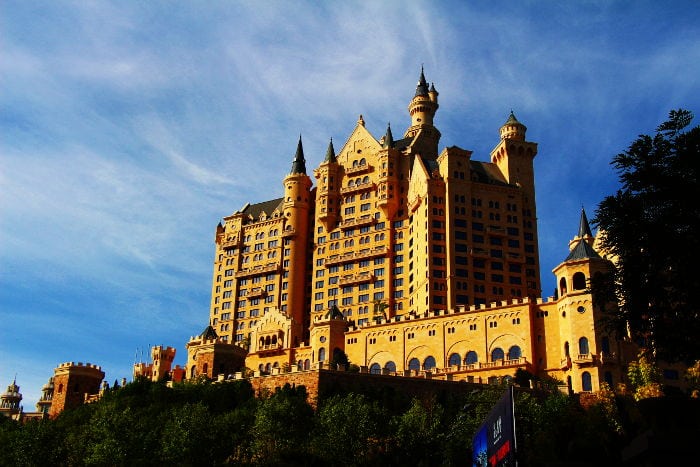 Building shaped like the Disney Palace in Xinghai Plaza
Building shaped like the Disney Palace in Xinghai Plaza
What to eat in Dalian
As a coastal city with a large fishing fleet, the local food stands out for its abundance of fish and seafood. At all local restaurants, you will find many dishes with shrimp, clams, cockles, squid, sea bream and other fish from the area.
The ways of preparing them are as varied as the products themselves, although it’s worth highlighting grilled and steamed dishes, which are usually garnished with shallots, onion and a sauce made from soy sauce and ginger that gives Dalian’s cuisine a characteristic flavor.
Local restaurants can be found everywhere in the city, although the greatest concentration is around Zhongshan Plaza, in the port area and in the area around Tiger Beach (Laohu Tan). Also, the night market on Tianjin pedestrian street offers the chance to try a large variety of barbecued items and other local specialties.
In addition, for a totally local experience, it is worth mentioning the restaurant 68-86 (Xinsheng Street, n 3). This restaurant has had a long history in the city and stands out for the quality of its products and its local specialties, among which it is worth highlighting Yuxian shrimp (鱼香虾仁) and clams in onion and soy sauce (葱油乌贝). Keep in mind that given that the restaurant isn’t touristy at all, the menu is only available in Chinese, although the photos help to recognize dishes.
Photo Credits: Photos by Nacho Garcia



